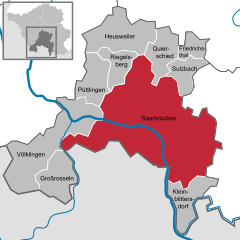Saarbrucken
| Saarbrücken | ||
|---|---|---|

Saarbrücken in January 2006
|
||
|
||
|
Location of Saarbrücken within Saarbrücken district
|
||
| Coordinates: 49°14′N 7°0′E / 49.233°N 7.000°ECoordinates: 49°14′N 7°0′E / 49.233°N 7.000°E | ||
| Country | Germany | |
| State | Saarland | |
| District | Saarbrücken | |
| Government | ||
| • Mayor | Charlotte Britz (SPD) | |
| Area | ||
| • Total | 167.07 km2 (64.51 sq mi) | |
| Population (2015-12-31) | ||
| • Total | 178,151 | |
| • Density | 1,100/km2 (2,800/sq mi) | |
| Time zone | CET/CEST (UTC+1/+2) | |
| Postal codes | 66001–66133 | |
| Dialling codes | 0681, 06893, 06897, 06898, 06805 | |
| Vehicle registration | SB | |
| Website | www.saarbruecken.de | |
| Largest groups of foreign residents | |
| Country of birth | Population (2014) |
|---|---|
|
|
3,851 |
|
|
2,292 |
|
|
2,245 |
|
|
1,555 |
|
|
1,000 |
Saarbrücken (German pronunciation: [zaːɐ̯ˈbʁʏkən], French: Sarrebruck [saʁ'bʁyk], Rhine Franconian: Saarbrigge [zɐ̯ːˈbrıgə]) is the capital and largest city of the state of Saarland, Germany. Saarbrücken is Saarland's administrative, commercial and cultural centre. The city is situated next to the French border at the heart of the metropolitan area of Saarland.
Saarbrücken was created in 1909 by the merger of three towns, Saarbrücken, St. Johann, and Malstatt-Burbach. It used to be the industrial and transport centre of the Saar coal basin. Products included iron and steel, sugar, beer, pottery, optical instruments, machinery, and construction materials.
Historic landmarks in the city include the stone bridge across the Saar (1546), the Gothic church of St Arnual, the 18th-century Saarbrücken Castle, and the old part of the town, the St. Johanner Markt (Sankt Johann market).
Twice in the 20th century Saarbrücken was separated from Germany: in 1920–35 as capital of the Territory of the Saar Basin and in 1947–56 as capital of the Saar Protectorate.
In modern German, Saarbrücken literally translates to Saar bridges (Brücken is the plural of ), and indeed there are about a dozen bridges across the Saar river; however the name actually predates the oldest bridge in the historic center of Saarbrücken, the Alte Brücke, by at least 500 years.
The name Saar stems from the Celtic word sara (streaming water), and the Roman name of the river, saravus.
However, there are three theories about the origin of the second part of the name Saarbrücken.
...
Wikipedia




